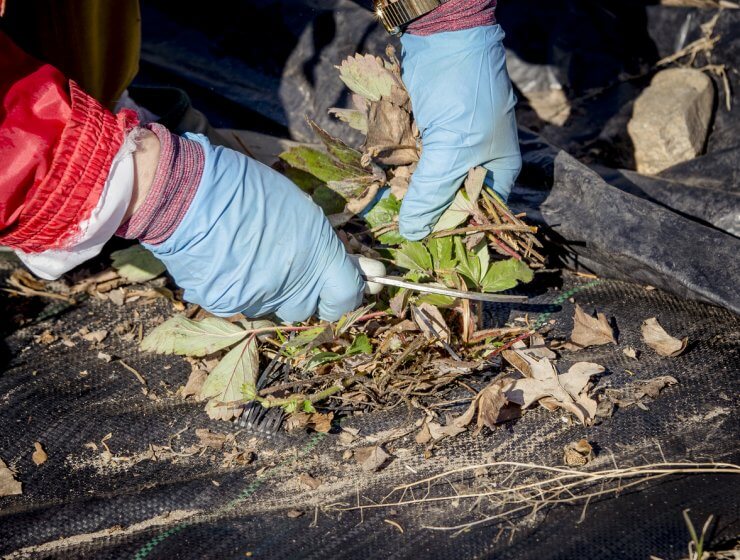
Winterizing strawberries
The first technique for winterizing strawberry plants is to choose an appropriate variety for your zone. Some varieties withstand cold better than others.
And if you do live in a region where the ground freezes in the winter, your strawberries will benefit from a few proactive measures to help them survive.
Tip: Container-grown plants can be prepared using these same methods and then placed in an unheated basement, shed, or garage to winter over.
Here are the steps for winterizing strawberry plants.
Renovation:
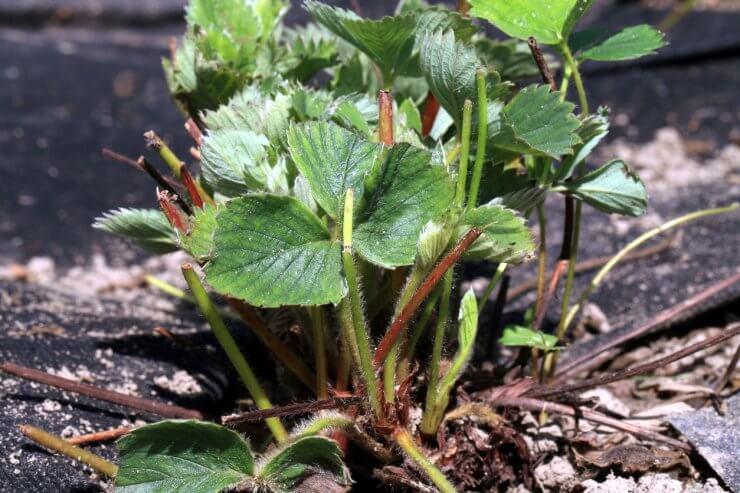
Strawberry plants cropped back for the winter
The first step is to trim your June-bearing plants back to 1 to 2 inches above the crown, no more than one week after harvest so you don’t risk damaging new young leaves. You can do this using pruning shears or hedge clippers, or, if appropriate, mowing over them with the blade set to the correct height. Remove the clippings and any weeds from the patch.
Discard any plants that have been weakened by bad weather, disease, or pests.
For everbearing and day-neutral varieties, prune off any leaves that appear damaged, diseased, or pest-infested. Remove the entire plant if necessary.
Renovation helps to control diseases by removing older leaves that are infected by leaf spot or fruit rot pathogens. It also helps control insects by removing their food source and potential breeding sites.
If you’re growing plants in rows, this is a good time to thin widening rows back to their original width, to improve air flow and reduce the time it takes leaves to dry and thus reduce disease severity.
Remove runners as needed to contain plants to the desired width. You can use a tiller to do this.
For plants not grown in rows, thin them to five plants per square foot, or about 4 to 6 inches apart.
Be sure to discard diseased and pest-infested foliage in the trash, not the compost heap! You don’t want those diseases and pests to infiltrate your compost.
Fertilize
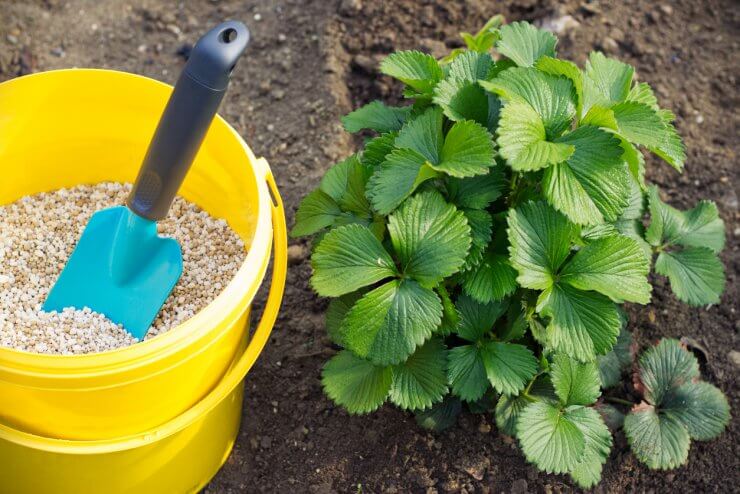
Fertilizer for strawberries
We recommend that you apply a balanced, 10-10-10 fertilizer at a quantity of about 5 pounds per 100 feet of row, or 1 pound per 25 plants, at least one month before your average first frost date.
Be careful not to get fertilizer on the foliage. Apply the fertilizer between plants in beds and containers, and in the aisles between rows. Water in thoroughly.
Water
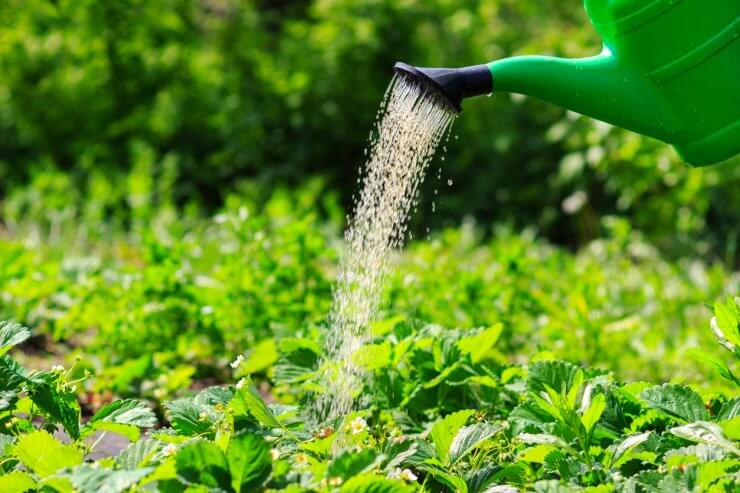
Watering strawberry plants
After renovating plants, continue to water right up to first frost. Provide 1 inch of supplemental water per week if it doesn’t rain. When plants are dormant during the cold months, you don’t have to do any watering, unless you have container-grown plants in a building, which will require just enough water to keep the soil from drying out completely.
Apply mulch
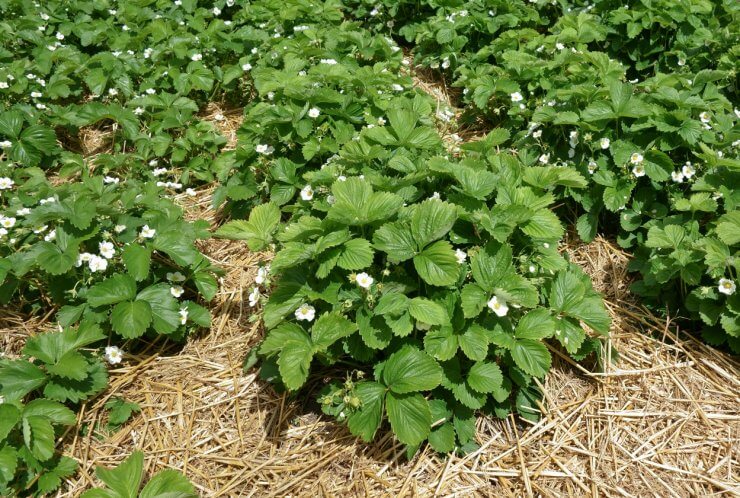
Strawberry plants with straw mulch
Mulch provides a layer of insulation, keeping them uniformly cold during temperature fluctuations, and it retains moisture essential to the crown’s health. Mulch also promotes good drainage.
The best time to apply mulch is between late November and early December, after first frost when most of the foliage is brown and floppy, and temperatures drop below 20 degrees F.
Don’t rush it: Laying mulch too soon may raise ground temperatures and promote new growth when you don’t want it and may also attract rodents that are still seeking winter shelter.
Drop mulch over plants by loose handfuls. You want the pieces to separate as they fall, creating airy heaps rather than tight clumps. Bury all visible foliage beneath a continuous cover of mulch, to the edges of the bed, raised bed, or container.
In the garden, you want a total cover of 3 to 5 inches of mulch. For raised beds, particularly pyramid planters, go for 6 to 8 inches, because air temperatures are colder than ground temperatures.
You can water the mulch down, or you may want to hold it in place with chicken wire held down by stakes, bricks, or rocks. The mulch will compact over time, so you may require additional applications over the winter months.
Tip: When it’s time to uncover plants in the spring, rake mulch into the aisles between rows to soak up spring rain and keep down mud in your patch. Leave some tucked around sprouts to inhibit weeds, retain moisture, and keep berries yet to come off the dirt. It’s also handy to have mulch nearby in case of a late-season frost. It will make good short-term protection in a hurry.
Have you successfully overwintered your strawberry plants? Please share your tips in with us.


 Previous
Previous


Question? I’ve got a duck house I clean weekly. Most of the straw is pretty clean can I use it to winter mulch? Good idea or bad? Only 3 ducks so it isn’t too dirty. Thanks
I don’t have experience with this, but the rule of manure in the garden is 120 days, so I’d give your straw the same treatment. Late fall mulching perhaps but not deep winter? Duck manure is actually one of the best!